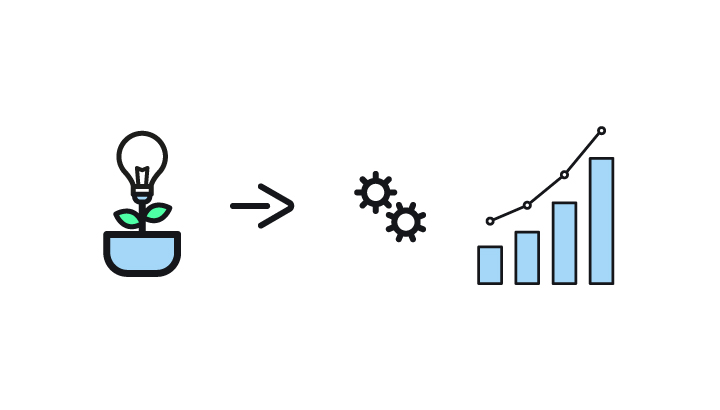Which is a more creative place to work: a startup company or an established enterprise organization? There’s a good chance you might pick the startup, whose very existence hinges on a creative idea for launching a new product or service.
But what about Apple, Google, or Amazon? These giant enterprises have managed to stay creative and innovative even after their formative years.
Creativity and innovation are certainly the watchwords of startup organizations, which have the characteristics baked into their approaches to product development. But how do more established companies continue to pull off creative innovation? Doesn’t too much bureaucracy make enterprise organizations less creative? If you’re a creative professional, is a startup company or an enterprise organization a better place to hang your artist’s beret?
Creativity and Productivity

Creativity at work should matter to everyone. Creativity fosters innovation that drives world-changing improvements in people’s lives.
But creativity is intangible until it makes something real. When creativity morphs into a new product, it can drive productivity, success, and ultimately, profit. The data tells us that most creative companies have the highest key performance indicators (KPIs) in growth and market share.
Every company wants innovation. Innovation is the key to new ideas that can improve the delivery of products and services. This usually equals profit, regardless of the size of the company. Forrester Consulting studied the idea of creativity and innovation in the workplace in order to try to quantify why and how these intangibles could improve a company’s bottom line. They found out that firms that foster a creative work environment:
- See positive revenue growth of 10% or higher in the following year
- Hold greater market share than their less creative competitors
- Attract more talent with their positive work environments
- Are early adopters of new technology tools
- Have a high-performance culture
- Win best places to work awards
- Fund new ideas that generate more revenue
How can a company — especially one with a big corporate bureaucracy — find and mine the creative spark to earn more revenue? What is the key to developing a culture of creativity in your workplace?
Finding Your Big Hairy Audacious Goal is the Key to Creativity

Creativity can be found in visionary companies like Facebook, Apple, Google, and Amazon. What all of these companies have in common, beyond creativity, is that they scaled from startups to enterprise organizations, yet somehow maintained their creativity as they grew. How did they do that?
Jim Collins would say it’s because they found their BHAG.
BHAG stands for “big hairy audacious goal” and it’s a term from Built to Last (1994), written by Jim Collins and Jerry Porras. The book chronicles a six-year study to determine what keeps the best companies successful even after they’ve grown into bureaucratic behemoths. Some of the companies they studied included:
- American Express
- Boeing
- Citicorp (Citigroup)
- Disney
- General Electric
- IBM
During the timeframe that these companies were studied, they used creativity to fuel innovation and outperform competitors. All of these companies had a BHAG that stimulated their progress. The book says:
“Like the moon mission, a true BHAG is clear and compelling and serves as a unifying focal point of effort — often creating immense team spirit. It has a clear finish line, so the organization can know when it has achieved the goal; people like to shoot for finish lines. A BHAG energizes people — it reaches out and grabs them in the gut. It is tangible, energizing, highly focused. People ‘get it’ right away; it takes little or no explanation.”
Finding your BHAG is one thing, but the key to business improvement is keeping the creative vibe even as you scale.
Keeping That Startup Vibe as You Scale
Entrepreneurs and their startup companies are everywhere.
In 2011, the Harvard Business Review described working at a startup as an “act of faith.” Today, you’ll find a lot of acts of faith in the market. Digital technology has enabled entrepreneurs to spring up at every coworking space, business incubator, or developer bootcamp. While some of these dreamers want to make millions, others just want to make a comfortable living doing what they’re passionate about. It’s that passion that exists within the goals of entrepreneurship. Startups are made successful by acts of faith, some creativity, and the passionate pursuit of a BHAG.
Some people discard the security of working at an established company because of the passion and creativity they find in a startup environment.
Creativity is naturally embraced in these companies because there is little bureaucracy, no established way of doing things, and it feels like you are taking on the world with something new, fresh, and exciting. There is a sense of ownership in these companies that is sometimes missing at enterprise organizations. There, you’ll find some employees who are passionate about the work, but enterprise organizations also have a lot of employees that view their work as just their job. Conversely, startups can’t afford to carry people that are just clocking in and out.
Startup organizations have a lot of trade-offs. The work-life balance may not be great, for example. But there is an undeniable creative spark in these adventurous, BHAG-loving dreamers that enterprise organizations envy. Growth can kill that creative spark, and startups that try to scale sometimes struggle to keep that scrappy do-it-yourself vibe. However, established organizations often seek to harness that creative startup spark by building innovation centers. But do they work?
Creative Innovation Centers Failing?
When enterprise organizations want to mimic the creative innovation found in startups, they build innovation centers. They are a separate division of the company that houses a laboratory environment for innovation. Cisco, Unilever, AT&T, Microsoft, and even Google all have innovation hubs. Big companies spend millions on these business tangents in the hopes that they’ll foster the same market-changing innovation found in many of today’s disruptive startup organizations. Walk into these places, and you’ll find a set of engaged team members with all the same accoutrements as a startup, from Post-its on the walls to beanbag chairs and Nerf guns.
But, ironically, Business Insider reports:
“There is no statistically significant relationship between financial performance and innovation spending, in terms of either total R&D dollars or R&D as a percentage of revenues. Many companies — notably, Apple — consistently underspend their peers on R&D investments while outperforming them on a broad range of measures of corporate success, such as revenue growth, profit growth, margins, and total shareholder return. Meanwhile, entire industries, such as pharmaceuticals, continue to devote relatively large shares of their resources to innovation, yet end up with much less to show for it than they — and their shareholders — might hope for.”
ZDNet calls innovation centers “hipster money pits” because they often fail to create the business models and products these companies need to beat back the encroachment by more creative startups. Some of the corporate labs that have been shut down include:
- Coca-Cola
- Disney
- Ogilvy
- Nordstrom
- The New York Times
- Turner Media
Many innovation labs are still doing great work and there is still a creative spark at a lot of huge companies listed on Fast Company’s top 50 lists of innovative companies this year, including Disney, Target, Apple, Domino’s, and even the NBA. But for every one of these established companies, there are two more that made the list that have grown from startup to enterprise in the last decade.
It seems like somewhere along the way, enterprise organizations lost and then failed to recover the creative spark that got them their millions. Perhaps they’re missing the one true thing that startups have: passionate people engaged in their BHAG.
Elements of a Creative Work Culture
 Here’s a startling idea: Instead of focusing on corporate revenue, focus on people first to foster a creative work culture.This could help them withstand the changes that come with growth. Entrepreneur puts it this way:
Here’s a startling idea: Instead of focusing on corporate revenue, focus on people first to foster a creative work culture.This could help them withstand the changes that come with growth. Entrepreneur puts it this way:
"To successfully scale your culture and remain a company that values innovation, focus on your relationships and not your bottom line. Your relationship with your employees is just as important as your relationship with customers.”
According to Business Insider, the one thing that all successful startups seem to have is an aligned business model, culture, and spending. The culture in startup organizations is generally highly creative, hard-working, and passionate.
If you’re trying to decide between the most creative workspace, it seems like startups should win, hands down.
The problem is that 95% of all product innovations fail and 92% of startups close. Should you give up a little job security for the creativity inherent in a startup? In the future, there are signs that you may not have to — at least in some companies.
McKinsey says 80% of enterprise executives say their current business models are at risk for disruption and 84% say creative innovation is a part of their growth strategy. Management at IBM agrees; a company survey selected creativity as the number one element for the company’s future success.
Here’s the rub that we touched on at the beginning of this article: Creativity is intangible. How can you create an environment that fosters creativity when the creative juice that keeps us innovating is impossible to define?
StartUp Nation says creativity in the workplace is all about a company culture that creates a safe space for new ideas within the context of business as usual. For enterprise organizations, this means allowing employees from the bottom up to shape their jobs in ways that streamline processes.
Think about how many times you’ve talked to someone complaining that company workflows are inefficient or just downright dumb? This is exactly why 70% of our employees are disengaged. It’s a big reason why people quit their jobs. Too many times our workers are disempowered to change the accepted standard for doing business. What would happen if these employees owned their work and innovated redundant processes?
Northeastern University suggests the following ways to increase the level of creativity in even the largest organization:
- Reward creativity and get comfortable with failure. Creative innovation can’t occur in a company that plays it safe all the time. What about creating a reward for the best idea that failed miserably? Creativity requires an environment where the attempt to innovate is just as important as the innovation itself.
- Don’t say “no,” say, “yes, and,” to improve the quality of brainstorming sessions in your departments. This acknowledges the validity of the employee’s idea and then adds to the creative riff by building upon it with your own idea.
- Use flexible work hours to maximize how people like to work. Some people are their most creative at 7am — or 7pm. We already know that allowing employees to work from home makes them happier and more productive. Allowing employee flextime can foster creativity and engagement by encouraging employees to work when they feel the most creative.
- Support work-life balance by allowing plenty of PTO to let your teams recharge. Most people feel recharged after some time away, and companies benefit by helping their workers avoid burning out.
- Attract the right talent. Hire for diversity of thought and life experience. Look for passion in your candidates and a variety of viewpoints and opinions about the world, in addition to skill sets. Check out the Ten Faces of Innovation, a list of candidate personas that you should have on your team.
The reality here is that all companies can foster creativity in the workplace. And you don’t need an innovation lab to do it.
Enterprise or Startup — Which Should You Choose?

Can an enterprise organization out-create a startup? Ask Facebook or Apple what they think. For a jobseeker in search of a creative work environment, deciding whether to go big or go the startup route should depend on one thing: culture.
A healthy employee work environment is a primary condition for inspiring creativity. The reason so many startups seem to win the workplace culture war is because of the passionate pursuit of the BHAG. Mokriya says, “Startups turn every challenge into an opportunity.” Startups’ very nature taking limited resources and turning them into something great fosters the culture of creativity that seems to be missing from enterprise organizations.
But companies like Google and Disney prove that big companies can foster creative innovation just as much as a startup can. The key is the people behind the work.
If you’re seeking a more creative work environment, talk to the team at Artisan Talent. We can help you get your mojo back — and put it to work.




